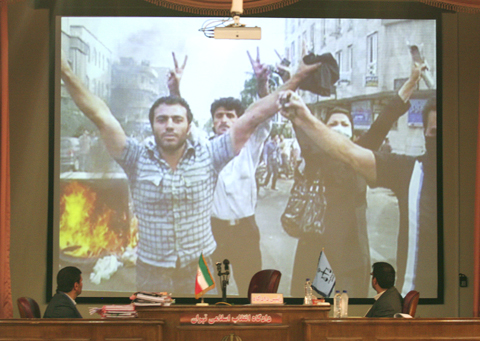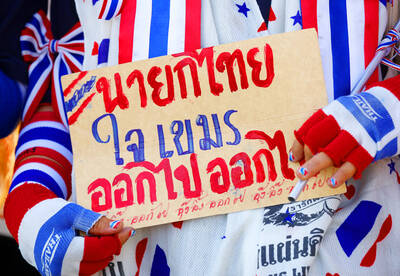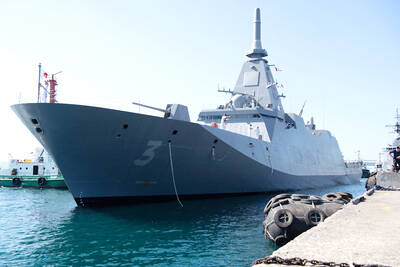Iranian President Mahmoud Ahmadinejad on Sunday attempted to soften his hardline image by nominating three women to his Cabinet following June’s disputed election.
As a new trial began of 25 more activists and opposition supporters, Ahmadinejad named Fatemeh Ajorlou, a member of parliament (MP), as social welfare minister and Marzieh Vahid Dastjerdi as health minister, with a third woman to be named later.
“With the 10th presidential election, we have entered a new era ... Conditions changed completely and the government [make-up] will see major changes,” Ahmadinejad said on state television.

PHOTO: AP
He also said Heydar Moslehi, his adviser on clerical affairs, would be nominated as intelligence minister. There were unconfirmed reports that the country’s chief nuclear negotiator, Saeed Jalili, would be named foreign minister.
Like Ahmadinejad, Jalili has taken an uncompromising stance in Iran’s dispute with the West over its nuclear program, which it defends as being for peaceful purposes.
But it is Ahmadinejad’s intention to have three women ministers that stands out in a society where women politicians are thin on the ground. There are only eight women among Iran’s 290 MPs.
During the election campaign, the defeated reformist candidate, Mir Hossein Mousavi, and his wife, Zahra Rahnavard, who holds a doctorate in political science, galvanized younger and female voters with promises to eliminate discrimination, abolish the “morality police” and “help the youth to think freely.”
Rahnavard emerged as the unlikely star of the presidential campaign. Ahmadinejad used a televised debate between the candidates to question the legitimacy of her doctorate. She then astonished the political establishment by accusing him of lying, debasing women and abusing his office, and threatened to sue him.
By seeking to promote women in his Cabinet, Ahmadinejad has taken on board the increased political clout of Iranian women, but the appointments — which have to be approved by parliament — are unlikely to appease reformists as both women named by Ahmadinejad are considered hardliners.
Mousavi announced plans over the weekend to create a political organization called the Green Path of Hope to restore constitutional rights. He said volunteer and social networks would form the mainstay of the organization, which he plans to be able to function legally within the political framework.
Mousavi said its goal would be to “defend the rights and votes of citizens that were crushed in the election.”
Following Ahmadinejad’s unexpectedly large majority in the June vote, hundreds of thousands of Mousavi’s supporters, wearing green, took to the streets claiming the election was fraudulent, in defiance of a government ban on political demonstrations.
Hardliners are increasingly calling for Mousavi to be put on trial along with hundreds of the regime’s opponents. During Sunday’s trial, one defendant, Mehrdad Aslani, accused Mousavi of planting the idea of election fraud in the mind of supporters. There have been no official indictments against Mousavi.
Earlier this month Iran held two other trials for more than 100 reformist politicians and activists accused of attempting to overthrow Iran’s Islamic system, including Hossein Rassam, chief political analyst at the British embassy and an Iranian citizen. The opposition has denounced the trials as a sham.

Eleven people, including a former minister, were arrested in Serbia on Friday over a train station disaster in which 16 people died. The concrete canopy of the newly renovated station in the northern city of Novi Sad collapsed on Nov. 1, 2024 in a disaster widely blamed on corruption and poor oversight. It sparked a wave of student-led protests and led to the resignation of then-Serbian prime minister Milos Vucevic and the fall of his government. The public prosecutor’s office in Novi Sad opened an investigation into the accident and deaths. In February, the public prosecutor’s office for organized crime opened another probe into

RISING RACISM: A Japanese group called on China to assure safety in the country, while the Chinese embassy in Tokyo urged action against a ‘surge in xenophobia’ A Japanese woman living in China was attacked and injured by a man in a subway station in Suzhou, China, Japanese media said, hours after two Chinese men were seriously injured in violence in Tokyo. The attacks on Thursday raised concern about xenophobic sentiment in China and Japan that have been blamed for assaults in both countries. It was the third attack involving Japanese living in China since last year. In the two previous cases in China, Chinese authorities have insisted they were isolated incidents. Japanese broadcaster NHK did not identify the woman injured in Suzhou by name, but, citing the Japanese

YELLOW SHIRTS: Many protesters were associated with pro-royalist groups that had previously supported the ouster of Paetongtarn’s father, Thaksin, in 2006 Protesters rallied on Saturday in the Thai capital to demand the resignation of court-suspended Thai Prime Minister Paetongtarn Shinawatra and in support of the armed forces following a violent border dispute with Cambodia that killed more than three dozen people and displaced more than 260,000. Gathered at Bangkok’s Victory Monument despite soaring temperatures, many sang patriotic songs and listened to speeches denouncing Paetongtarn and her father, former Thai prime minister Thaksin Shinawatra, and voiced their backing of the country’s army, which has always retained substantial power in the Southeast Asian country. Police said there were about 2,000 protesters by mid-afternoon, although

MOGAMI-CLASS FRIGATES: The deal is a ‘big step toward elevating national security cooperation with Australia, which is our special strategic partner,’ a Japanese official said Australia is to upgrade its navy with 11 Mogami-class frigates built by Japan’s Mitsubishi Heavy Industries, Australian Minister for Defence Richard Marles said yesterday. Billed as Japan’s biggest defense export deal since World War II, Australia is to pay US$6 billion over the next 10 years to acquire the fleet of stealth frigates. Australia is in the midst of a major military restructure, bolstering its navy with long-range firepower in an effort to deter China. It is striving to expand its fleet of major warships from 11 to 26 over the next decade. “This is clearly the biggest defense-industry agreement that has ever